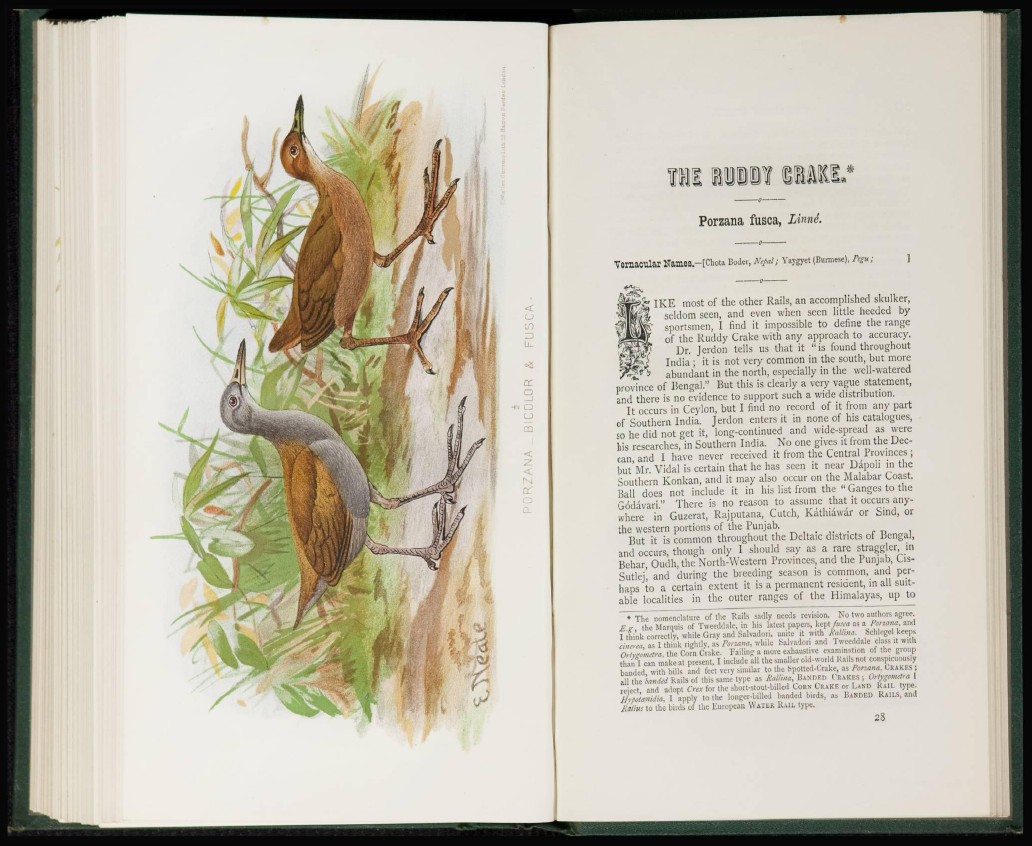
rai ü iw ©M
Porzana fusca, Linné.
Vernacular ITamOS.—[Chota Boder, Nepal; Yaygyet (Burmese), Pegu; ]
IKE most of the other Rails, an accomplished skulker,
seldom seen, and even when seen little heeded by
sportsmen, I find it impossible to define the range
of the Ruddy Crake with any approach to accuracy.
Dr. Jcrdon tells us that it " is found throughout
India ; it is not very common in the south, but more
abundant in the north, especially in the well-watered
province of Bengal." But this is clearly a very vague statement,
and there is no evidence to support such a wide distribution.
It occurs in Ceylon, but I find no record of it from any part
of Southern India. Jcrdon enters it in none of his catalogues,
so he did not get it, long-continued and wide-spread as were
his researches, in Southern India. No one gives it from the Deccan,
and I have never received it from the Central Provinces ;
but Mr. Vidal is certain that he has seen it near Dapoli in the
Southern Konkan, and it may also occur on the Malabar Coast.
Ball does not include it in his list from the " Ganges to the
Godavari." There is no reason to assume that it occurs anywhere
in Guzerat, Rajputana, Cutch, Kathiawar or Sind, or
the western portions of the Punjab.
But it is common throughout the Deltaic districts of Bengal,
and occurs, though only I should say as a rare straggler, in
Behar, Oudh, the North-Western Provinces, and the Punjab, Cis-
Sutlej, and during the breeding season is common, and perhaps
to a certain extent it is a permanent resident, in all suitable
localities in the outer ranges of the Himalayas, up to
* The nomenclature of the Rails sadly needs revision. No two authors agree.
E.g, the Marquis of Tweeddale, in his latest papers, kept fusca as a Porzatia. and
I think correctly, while Gray and Salvadori, unite it with A'ulli'ua. Schlegel keeps
cinetea, as I think rightly, as Porzatia, while Salvadori and Tweeddale class it with
Ortygometra, the Corn Crake. Failing a more exhaustive examination of the group
than I can make at present, I include all the smaller old-world Rails not conspicuously
banded, with bills and feet very similar to the Spotted-Crake, as Porzatia. C R A K E S ;
all the banded kails of this same type as Rallina, B A N D E D ( ' R A K E S ; Ortygometra I
reject, and adopt Crex for the short-stout-billed C O R N C R A K E or L A N D K A I L type.
J/vpota-niJt'a, I apply to the longer-hilled handed birds, as B A N D E D R A I L S , and
Kallm to the biids of the European W A T E R R A I L type.